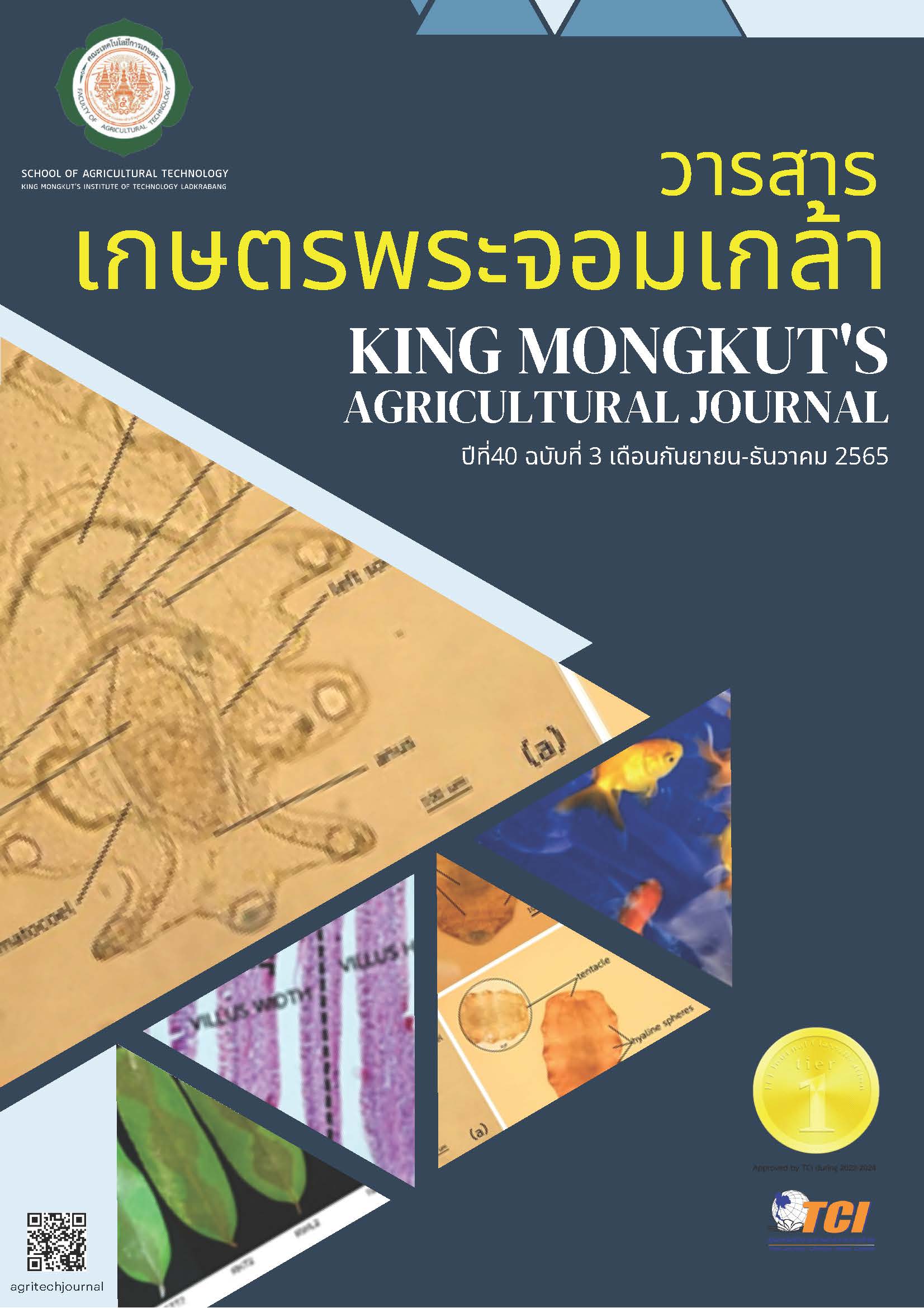การทดแทนปลาป่นด้วยดักแด้ไหมอีรี่ (Samia ricini) หรือดักแด้ไหมพันธุ์ไทยลูกผสม (j108 x Nhaglai) ในอาหารปลาทอง (Carassius auratus) ต่อสมรรถภาพการเจริญเติบโต ความเข้มสี และดัชนีสุขภาพ
Main Article Content
บทคัดย่อ
ดักแด้ไหมอีรี่ (ESM) และดักแด้ไหมพันธุ์ไทยลูกผสม j108 x Nhaglai (CSM) ป่นได้รับการประเมินเพื่อใช้ทดแทนปลาป่นในสูตรอาหารปลาทอง ต่อสมรรถภาพการเจริญเติบโต ความเข้มสี และดัชนีสุขภาพ โดยใช้ปลาทองอายุสองสัปดาห์ ได้รับอาหารที่มี ESM และ CSM แทนที่ปลาป่นที่ระดับ 0%, 25%, 50%, 75% และ 100% เป็นระยะเวลา 12 สัปดาห์ ซึ่งอุณหภูมิของน้ำอยู่ในช่วงระหว่าง 25 ถึง 29 ◦ซ ในตู้ปลาจำนวน 30 ตู้ (ขนาด 1.5 ลบ.ม.) ภายใต้ระบบหมุนเวียนน้ำ ทั้งนี้จากผลการทดลองพบว่า น้ำหนักสุดท้ายของปลามีค่าสูงที่สุดในปลาที่เลี้ยงด้วยอาหาร ESM (100%) นอกจากนี้ปลาที่ได้รับ CSM แทนที่ FM ที่ระดับ 25% ในสูตรอาหาร มีน้ำหนักสุดท้าย และอัตราการเจริญเติบโตสูงสุดอย่างมีนัยสำคัญ (P<0.05) อีกทั้งปลาที่เลี้ยงด้วย ESM 25% และ 50% มีค่าความเข้มสีเหลือง (b*) ของสีผิว และดัชนีตับ (HSI) สูงกว่ากลุ่มควบคุมอย่างมีนัยสำคัญทางสถิติ (P<0.05) ในทางตรงกันข้ามค่าความสว่าง (L*), ความเข้มสีแดง (a*), b* ของสีผิว และดัชนีสุขภาพในกลุ่มที่ได้รับ CSM ไม่พบความแตกต่างทางสถิติ (P>0.05) ดังนั้น ผลลัพธ์เหล่านี้แสดงให้เห็นได้ชัดเจนว่า ESM และ CSM สามารถแทนที่ FM ได้ถึง 25% ในอาหารปลาทอง นอกจากนี้ ESM และ CSM ยังสามารถใช้เพิ่มความเข้มของสีของผิวปลาทองได้อีกด้วย
Article Details

อนุญาตภายใต้เงื่อนไข Creative Commons Attribution-NonCommercial-NoDerivatives 4.0 International License.
วารสารเกษตรพระจอมเกล้า
เอกสารอ้างอิง
Alegbeleye, W. O., Obasa, S. O., Olude, O. O., Otubu, K., & Jimoh, W. (2012). Preliminary evaluation of the nutritive value of the variegated grasshopper (Zonocerus variegatus L.) for African catfish Clarias gariepinus (Burchell. 1822) fingerlings. Aquaculture Research. 43(3), 412-420.
Begum, N. N., Chakraborty, S. C., Zaher, M., Abdul, M. M., & Gupta, M. V. (1994). Replacement of fishmeal by low-cost animal protein as a quality fish feed ingredient for indian major carp, labeo rohita, fingerlings. Journal of the Science of Food and Agriculture. 64(2), 191-197.
Chieco, C., Morrone, L., Bertazza, G., Cappellozza, S., Saviane, A., Gai, F., Di Virgilio, N., & Rossi, F. (2019). The effect of strain and rearing medium on the chemical composition, fatty acid profile and carotenoid content in silkworm (Bombyx mori) pupae. Animals. 9(3), 103-116.
Dheke, S., & Gubhaju, S. R. (2013). Growth response of rainbow trout (Oncorhynchus mykiss) on substitution of shrimp meal by different protein sources. Nepalese Journal of Zoology. 1(1), 24-29.
Hasan, M. (2001). Nutrition and feeding for sustainable aquaculture development in the third millennium. In The 3rd Technical Proceedings of the Conference on Aquaculture. (pp. 193-219). Rome: Food and Agriculture Organization of the United Nations.
Henry, M., Gasco, L., Piccolo, G., & Fountoulaki, E. (2015). Review on the use of insects in the diet of farmed fish: past and future. Animal Feed Science and Technology. 203, 1-22.
Hossain, M., Nahar, N., & Kamal, M. (1997). Nutrient digestibility coefficients of some plant and animal proteins for rohu (Labeo rohita). Aquaculture. 151(1-4), 37-45.
Jahanbakhshi, A., Pourmozaffar, S., Adeshina, I., Mahmoudi, R., Erfanifar, E., & Ajdari, A. (2021). Selenium nanoparticle and selenomethionine as feed additives: Effects on growth performance, hepatic enzymes’ activity, mucosal immune parameters, liver histology, and appetite-related gene transcript in goldfish (Carassius auratus). Fish Physiology and Biochemistry. 47(2), 639-652.
Jeyachandran, P., & Paulraj, S. (1976). Experiments with artificial feeds on Cyprinus carpio fingerlings. Journal of Inland Fisheries Society of India. 8(1976), 33-37.
Karthick Raja, P., Aanand, S., Stephen Sampathkumar, J., & Padmavathy, P. (2019). Silkworm pupae meal as alternative source of protein in fish feed. Journal of Entomology and Zoology Studies. 7(4), 78-85.
Kotake-Nara, E., Yamamoto, K., Nozawa, M., Miyashita, K., & Murakami, T. (2002). Lipid profiles and oxidative stability of silkworm pupal oil. Journal of Oleo Science. 51(11), 681-690.
Longvah, T., Mangthya, K., & Ramulu, P. (2011). Nutrient composition and protein quality evaluation of eri silkworm (Samia ricinii) prepupae and pupae. Food chemistry. 128(2), 400-403.
Meicai, W., & Gaoqiang, L. (2001). The research and exploitation of insect protein. Journal of Central-south Forestry College. 21(2), 86-90.
Putra, D. F., Qadri, A., El-Rahimi, S. A., & Othman, N. (2020). Effects of astaxanthin on the skin color of green swordtail, Xyphophorus helleri. E3S Web of Conferences. 151, 01065-01069.
Rana, K. J., Siriwardena, S., & Hasan, M. R. (2009). Impact of rising feed ingredient prices on aquafeeds and aquaculture production. Stirling: University of Stirling.
Rangacharyulu, P., Giri, S., Paul, B., Yashoda, K., Rao, R. J., Mahendrakar, N., Mohanty, S., & Mukhopadhyay, P. (2003). Utilization of fermented silkworm pupae silage in feed for carps. Bioresource Technology. 86(1), 29-32.
Rumpold, B. A., & Schlüter, O. K. (2013). Potential and challenges of insects as an innovative source for food and feed production. Innovative Food Science & Emerging Technologies. 17, 1-11.
Sales, J., & Janssens, G. P. (2003). Nutrient requirements of ornamental fish. Aquatic Living Resources. 16(6), 533-540.
Sheikh, I., Banday, M., Baba, I., Adil, S., Nissa, S. S., Zaffer, B., & Bulbul, K. (2018). Utilization of silkworm pupae meal as an alternative source of protein in the diet of livestock and poultry: a review. Journal of Entomology and Zoology Studies. 6(4), 1010-1016.
Tacon, A. G., Metian, M., & Hasan, M. R. (2009). Feed ingredients and fertilizers for farmed aquatic animals: sources and composition. Rome: Fisheries and Aquaculture Management Div.
Tola, S., Bureau, D. P., Hooft, J. M., Beamish, F. W., Sulyok, M., Krska, R., Encarnação, P., & Petkam, R. (2015). Effects of wheat naturally contaminated with Fusarium mycotoxins on growth performance and selected health indices of red tilapia (Oreochromis niloticus × O. mossambicus). Toxins. 7(6), 1929-1944.
Wanchooplao, N., Jintasataporn, O., Tabthipwon, P., & Areechon, N. (2009). Utilization of protein hydrolysates from Eri silkworm pupae (Philosamia ricini) in giant freshwater prawn (Macrobrachium rosenbergii). In The Proceedings of 47th Kasetsart University Annual Conference. (pp. 1-47). Bangkok: Kasetsart University.


